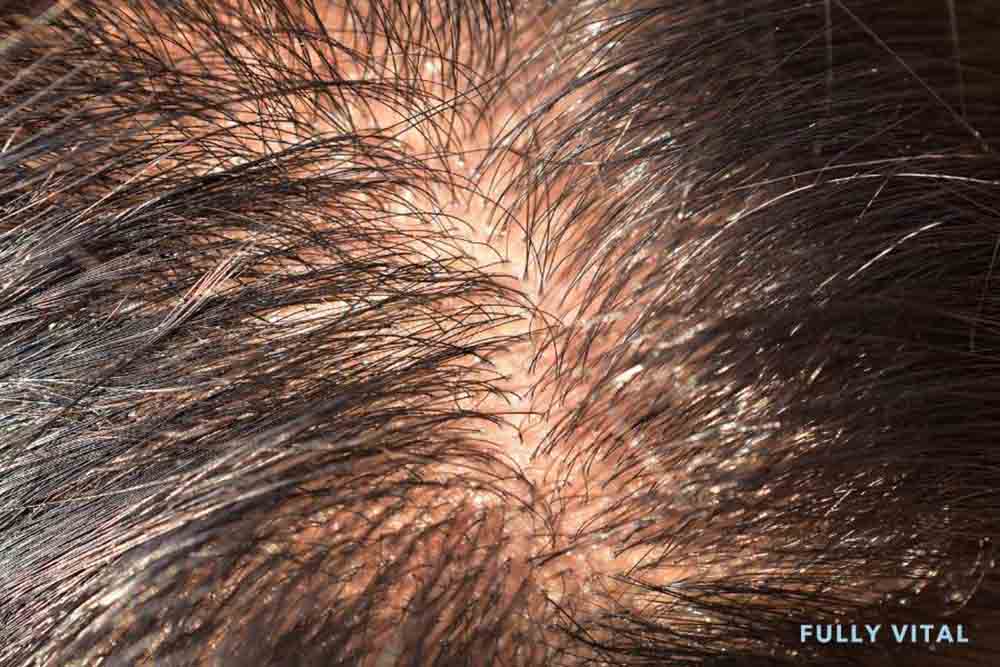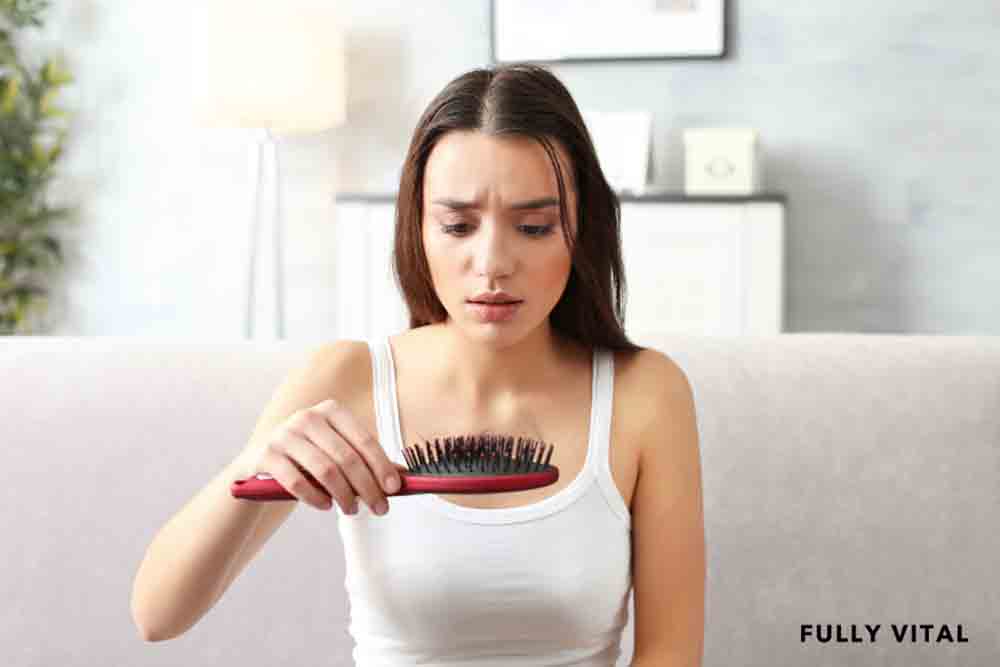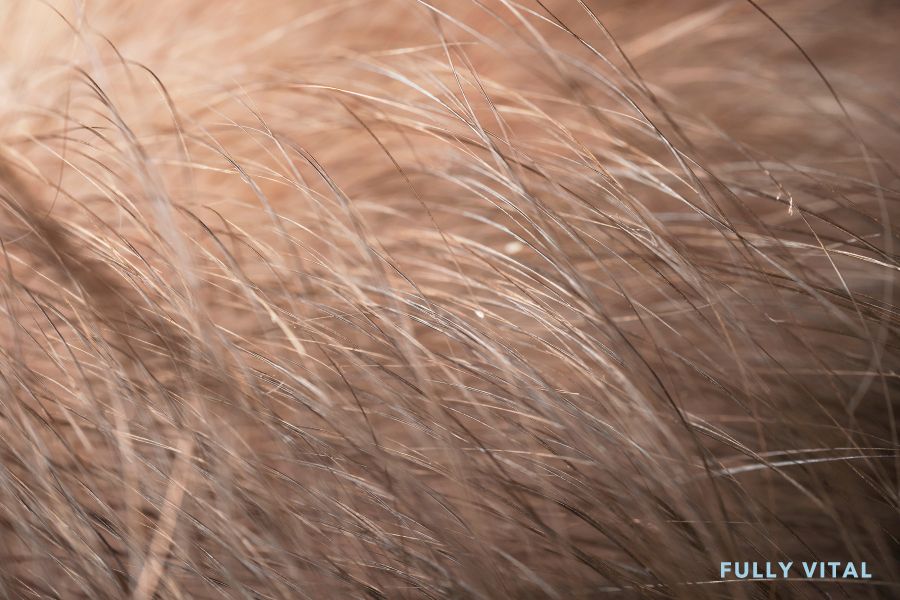
Unlocking The Secrets Of Club Hair: Your Guide To Healthy Hair Growth
Step into the world of vibrant hair growth as we unravel the mysteries of "club hair."
In this guide, we'll explore its significance, its role in the hair growth cycle, and how it impacts your journey to luscious locks.
Whether your hair is straight, curly, or wavy, join us in understanding the key to healthy, flourishing hair.

I LOVE MY HAIR NOW
FullyVital hair serum and hair vitamins made tremendous improvements in my hair. I truly love my hair now.
Dorit S.,
How Do You Know If You Have Club Hair?
Distinctive Root Appearance: Recognizing the Bulb-Like Root
When it comes to identifying club hair, one of the most prominent features to look for is the bulb-like root at the end of the hair strand.
This root gives the hair a unique appearance, resembling a small club or a rounded bulb.
As your hair progresses through its growth cycle, reaching the shedding phase, the hair follicle undergoes changes that result in this distinctive root structure.
Spotting Club Hair: Identifying Characteristics on Your Hairbrush
One common place to notice club hair is on your hairbrush or comb after brushing or styling your hair.
When examining the fallen strands, pay close attention to the base of the hairs. Club hairs will stand out due to the slightly widened root area that forms the characteristic bulb shape.
As these hairs are no longer actively growing, they are preparing to shed, making way for new hair growth.
Shower Observations: Noticing Club Hairs in the Shower
Another opportunity to identify club hair is during your shower routine.
As you wash and condition your hair, take a moment to observe the strands that collect on your hands or gather near the drain.
Among these strands, you may notice some with the telltale bulb-like root formation.
These are indicators that your hair is progressing through its growth cycle, with club hairs making their way to the shedding phase.

Why Is It Called Club Hair?
The term "club hair" originates from the distinct shape of its root. The root is thicker at the bottom, resembling a club or bulb.
This unique feature is a result of the hair follicle transitioning from the active growth phase to the resting phase.1
How Do You Find Club Hair?
Locating club hair is an enlightening aspect of understanding your hair's growth cycle and health.
As your hair undergoes its natural progression, certain strands will naturally reach the shedding phase, signifying the presence of club hair. To effectively find club hair, follow these steps:
Observe the Base
During your regular hair care routine or when you notice fallen strands, take a closer look at the base of the hairs.
Club hairs are characterized by a slightly widened root area that resembles a bulb or club-like shape.
This unique feature is a result of the hair follicle transitioning from the active growth phase to the resting phase.
Brush Examination
After brushing your hair, inspect your hairbrush or comb.
Among the collected strands, you may notice hairs with the distinct bulb-like root formation.
These are examples of club hairs that have completed their growth cycle and are preparing to shed.
Shower Insights
As you wash and condition your hair in the shower, keep an eye on the strands that gather on your hands or accumulate near the drain.
Among these strands, you might identify some with the characteristic club-shaped root.
These are indicative of hairs that have reached the end of their growth cycle.
Texture and Appearance
Apart from the root structure, club hairs might also have a slightly different texture or appearance compared to actively growing hairs.
They might appear slightly thinner or more fragile, reflecting the transitional stage they are in.
Tracking Shedding Patterns
Over time, you may notice certain patterns in your hair shedding.
If you consistently find hairs with bulb-like roots, it indicates that your hair is progressing through its natural cycle.
This can be a helpful way to monitor your hair's health and the regularity of shedding.
What Is An Example Of Club Hair?
Imagine you're examining your hairbrush after brushing your hair.
Among the fallen strands, you notice a few hairs with a slightly enlarged root that gives them a distinctive shape.
These hairs are examples of club hairs. They've completed their growth cycle and are about to be replaced by new hair sprouts.
Which Hair Growth Phase Represents Club Hair?
Club hair is closely linked to the final phase of the hair growth cycle, known as the telogen phase.
During this phase, the hair follicle is at rest and detaches from the blood supply. This detachment leads to the formation of the bulb-like root, characterizing the club hair.2
Eventually, the club hair will shed to pave the way for the anagen phase, where new hair growth begins.
What Is Club Hair?
Club hair refers to the final stage of the hair growth cycle, known as the telogen phase.
During this phase, the hair follicle transitions from active growth to rest, leading to the formation of a bulb-like root.
This unique root structure characterizes club hair, setting it apart from hairs in other phases.
Why Is Club Hair Important?
Club hair is a natural phenomenon that signals the conclusion of a hair's growth cycle.
While it might seem counterintuitive, the shedding of club hair is an essential part of the renewal process.
This shedding allows the scalp to make way for new hair growth, ensuring the continuous cycle of hair renewal.
How Does Club Hair Work?
The process of club hair formation is a complex interplay between the hair follicle's growth and resting phases. Here's a simplified breakdown:
Anagen Phase
This is the active growth phase where hair strands are produced.
Catagen Phase
Hair growth slows down, and the follicle prepares for the transition to the resting phase.
Telogen Phase (Club Hair Phase)
The hair follicle detaches from the blood supply and enters a resting state.3
The root of the hair bulb widens, forming the characteristic club shape.
Exogen Phase
The club hair eventually sheds, making way for new hair growth to begin anew.
What Are The Benefits Of Club Hair?
Club hair's importance lies in its role within the natural hair growth cycle.
The benefits include:
Healthy Renewal
Shedding club hairs allows for the continuous cycle of hair renewal, maintaining scalp health.
Space for New Growth
Clearing out older hairs paves the way for new hair to emerge, contributing to a fuller head of hair.
Cycle Synchronization
The shedding of club hairs ensures synchronization of the hair growth cycle, promoting overall hair health.
Are There Any Downsides To Club Hair?
While club hair shedding is a normal and natural part of the hair growth process, there can be certain downsides or considerations to be aware of:
Excessive Shedding
While some shedding of club hair is expected, excessive shedding could be a cause for concern.
If you notice a significant increase in hair shedding, it might indicate underlying health issues, hormonal imbalances, or improper hair care practices.
Consulting a healthcare professional or dermatologist in such cases is recommended.
Hair Health Issues
Excessive shedding of club hair might be a symptom of various hair health problems, including conditions like telogen effluvium, which is characterized by increased hair shedding due to stress, illness, or other triggers.
If you suspect a hair health issue, seeking medical advice can help diagnose and address the underlying cause.
Impact on Volume
While shedding club hair is necessary for the renewal of hair growth, excessive shedding over time can impact the overall volume and density of your hair.
If you consistently lose a significant amount of hair, you might notice a reduction in hair thickness and fullness.
Emotional Impact
Experiencing noticeable hair shedding, even if it's a normal part of the growth cycle, can lead to emotional stress and concerns about hair health and appearance.
It's important to maintain a balanced perspective and seek support if you're feeling distressed.
Hair Care Practices
Overly aggressive hair care practices, such as frequent use of heat styling tools, tight hairstyles, or harsh chemicals, can contribute to increased hair shedding. Being mindful of how you treat your hair can help minimize unnecessary shedding.
Nutritional Factors
Poor nutrition, deficiencies in certain vitamins and minerals, and crash diets can affect hair health and contribute to increased shedding, including club hair shedding.

Experience The Power Of Fully Vital's Hair Growth SolutionsUnveil the secret to maintaining a vibrant and youthful hair journey with Fully Vital's revolutionary hair growth products. Our mission is simple: to provide you with science-backed solutions that combat the signs of hair aging, enabling you to cultivate a healthier and more resilient connection with your locks. Key Features:
Discover the transformation that awaits as you embark on a journey to healthier, more youthful hair. Fully Vital invites you to experience the difference – a difference that can redefine your relationship with your hair. |
Final Thoughts On Club Hair
As we wrap up our exploration of club hair and its significance in the hair growth cycle, it's clear that understanding this natural process is key to nurturing your locks.
By recognizing the role of club hair shedding in promoting vibrant new growth, you're equipped with the knowledge to care for your hair at every phase of its journey.
Remember, the hair growth cycle is a dynamic process that involves various stages, including the formation and shedding of club hairs.
Embrace this cycle as an opportunity for renewal, rejuvenation, and the chance to maintain a strong and healthy relationship with your hair.
At Fully Vital, we're committed to empowering you on your hair growth journey.
Our variety of hair growth products is designed to support your locks' health, helping you maintain the vitality and radiance you deserve.
Experience the transformative power of nourished hair, and seize the opportunity to enjoy the beauty of your locks at every stage.
Discover more about unlocking the potential of your hair's growth with Fully Vital's range of hair care products, tailored to ensure a vibrant and healthy relationship with your locks.
Frequently Asked Questions About Club Hair
Is it normal to have a mix of club hair and growing hair?
Yes, it's common to have a combination of club hairs and actively growing hairs on your scalp.
This indicates a healthy hair growth cycle.
Can club hair be a sign of a hair health issue?
While some shedding of club hair is normal, excessive shedding could indicate underlying hair health problems.
Consulting a dermatologist can help identify any potential issues.
Can I accelerate the transition from club hair to new growth?
While you can't speed up the natural hair growth cycle, maintaining a balanced diet, using suitable hair products, and practicing good hair care habits can promote overall hair health.
Does everyone experience club hair?
Yes, club hair is a natural part of the hair growth cycle.
Everyone goes through this phase as part of the ongoing renewal process.
Can club hair be prevented?
Club hair shedding is a natural process that can't be entirely prevented.
However, adopting a healthy lifestyle and hair care routine can minimize excessive shedding and promote optimal hair growth.
How Is Club Hair Formed?
Club hair formation occurs during the telogen phase, the final stage of the hair growth cycle.
As the hair follicle transitions from active growth to rest, the bulb-like root forms, giving the hair its distinct club shape.
This is a natural process that signifies the completion of a hair's growth cycle.
How Do I Know If My Hair Is in Anagen Phase?
Determining the specific phase of the hair growth cycle requires a closer look at the characteristics of the hair strand.
Anagen phase hairs are typically longer, thicker, and firmly rooted in the scalp.
They are in their active growth stage and contribute to the overall volume and length of your hair.
How Does Hair Know When to Stop Growing?
The hair growth cycle is regulated by a combination of genetics and hormonal signals.
Each hair follicle has a predetermined growth phase duration, which is influenced by factors such as genetics, hormones, and age.
Once a hair follicle completes its growth phase, it enters the telogen phase, leading to the shedding of the club hair.
Is Hair Dead When It Leaves the Scalp?
Yes, once a hair strand emerges from the scalp, it is considered non-living. The living cells responsible for hair growth are located within the hair follicle in the scalp.
The visible part of the hair strand is composed of keratin, a protein that provides strength and structure but lacks the ability to repair itself once damaged.
What Does Anagen Hair Look Like?
Anagen hair is characterized by its vibrant appearance and active growth.
It is typically longer, thicker, and displays a healthy shine.
Anagen hairs are firmly anchored in the scalp and contribute significantly to the overall volume and density of your hair.
How Do You Push Your Hair into Anagen Phase?
While you can't directly control the hair growth cycle, you can promote a healthy anagen phase through various practices:
-
Balanced Diet: Providing your body with essential nutrients, particularly those important for hair health, can support optimal growth.
-
Proper Hair Care: Using suitable hair care products, gentle handling, and avoiding excessive heat and styling stress can maintain healthy hair.
-
Stress Management: Chronic stress can impact hair growth. Engaging in stress-reducing activities can indirectly support a healthy hair growth cycle.
How Many New Hairs Grow a Day?
On average, individuals can experience anywhere from 50 to 100 hairs shedding each day.
However, this number can vary based on factors such as genetics, age, and overall health.
It's important to note that the hair growth cycle is a continuous process, with new hairs sprouting as older ones shed.
Sources:
-
Hoover, E., Alhajj, M., & Flores, J. L. (2020). Physiology, Hair. PubMed; StatPearls Publishing. https://www.ncbi.nlm.nih.gov/books/NBK499948/
-
Information, N. C. for B., Pike, U. S. N. L. of M. 8600 R., MD, B., & Usa, 20894. (2019). What is the structure of hair and how does it grow? In www.ncbi.nlm.nih.gov. Institute for Quality and Efficiency in Health Care (IQWiG). https://www.ncbi.nlm.nih.gov/books/NBK546248/
-
Brown, T. M., & Krishnamurthy, K. (2020). Histology, Hair and Follicle. PubMed; StatPearls Publishing. https://www.ncbi.nlm.nih.gov/books/NBK532929/







